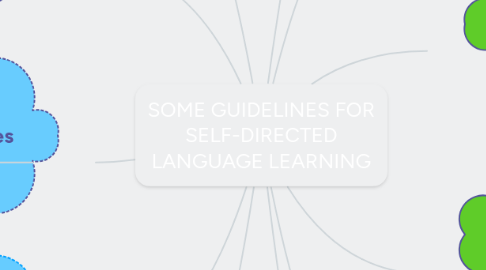
1. B1 level competence
1.1. The student is expected to be able to function INDEPENDENTLY using the language. B1 is generally enough to carry on basic one-on-one conversations and handle most tourist tasks.
1.2. Marco Legal Galicia: Decreto 81/2018, do 19 de xullo, polo que se establece o currículo dos nivéis das ensinanzas de idiomas de réxime especial
1.3. British Council explanation
1.4. Test your level using Cambridge B1 PET model exams
1.4.1. Exam English PET practice
1.4.2. Cambridge B1 Preliminary for schools
1.4.3. Cambridge B1 sample papers
2. The B1 Certification exam
2.1. Guide for candidates (Galicia)
2.2. EOI Santiago 2019-2020 course syllabus and evaluation criteria/instruments
2.3. Model B1 Certification exams before 2019 (Galicia)
2.4. Model B1 certification exams (other Autonomous Communities)
3. Effective learning strategies
3.1. Understand your role and your teacher's role in your learning outcomes, and apply effective learning strategies
3.2. Follow the advice of successful language learners like these polyglots!!
3.2.1. Listen to what Susanna Zaraysky has done to learn 7 languages fluently (you might be very very surprised)
3.2.2. Alex Rawlings (who speaks 21 languages) tells you 4 ways to get better at languages.
4. Successful learner characteristics
4.1. Are YOU a good language learner? Do you know what characteristics generally define good language learners? Click on the link and find out. Also, take the questionnaire.
4.2. 4 things you should have in place to become a successful language learner
4.2.1. 1. What's your motivation for learning English?
4.2.1.1. Do you assume responsibility for staying motivated?
4.2.2. 2. Have you set REASONABLE goals and expectations?
4.2.3. 2. Do YOU dedicate the right amount of TIME to meet those goals and expectations?
4.2.4. 4. Do YOU actively look for materials, resources and tools to help you meet your goals?
4.2.4.1. Don't forget to consult collaborative learning tools like Padlet, Edmodo, Flipgrid, your classroom notes.....
5. VOCABULARY
5.1. Know what a B1 learner's English vocabulary repertoire should look like.
5.2. Consolidate and build common vocabulary on everyday topics.
5.3. Follow tips for learning vocabulary
5.3.1. Fluent U
5.3.2. British Council on learning new words
5.4. Use flashcards: Read the linked article to understand WHY they work
5.4.1. Quizlet
5.4.2. CRAM flashcard maker
5.4.3. Use flashcard apps: Anki, Voxy, Brainscape, British Council.....
5.5. Use mind maps to organize and classify vocabulary by topics, categories, word classes, etc. It has been suggested that mind-mapping can improve learning/study efficiency up to 15% over conventional study methods
5.6. Try to learn about 8 new words a day and use them. Did you know that you have to USE new words at least 10 times/day to learn them?
5.6.1. Merriam-Webster's learner's word of the day
5.6.2. MacMillian's word of the day
5.6.3. Dictionary.com's word of the day
5.7. Do word puzzles and games like crosswords, anagrams and word searches.
5.7.1. Boatload Crossword puzzle of the day
5.7.2. Word search puzzles
5.7.3. Arkadium online word games
5.8. READ, READ, READ!!!!
5.9. Know how to use a bilingual and a monolingual dictionary
6. GRAMMAR
6.1. Review and consolidate B1 (intermediate) and previous level structures, especially the ones listed in the link and the often problematic ones detailed in this mind map.
6.2. Expressing future plans & intentions: "to be going to", present continuous, present simple
6.3. Know when to use WILL/WON'T correctly!!
6.3.1. Go to Woodward English for a detailed explanation and exercises
6.4. Present perfect vs. past simple
6.5. Zero and 1st conditionals
6.6. Passive voice (present and past passive)
6.6.1. Englishgrammarhere.com
6.7. Know when to use the 3 verb FORMS correctly: "to" infinitives, gerunds, & bare infinitives
6.8. Know phrasal verbs used to talk about common topics. Know the difference between separable/inseparable phrasal verbs and word order
6.9. Adverbs of manner
6.10. Comparative and superlative adjectives and adverbs
6.11. Modal verbs: permission, obligation, prohibition, necessity
6.12. Modals "may" and "might"
6.13. -ed and -ing adjectives
7. SPEAKING & PRONUCIATION
7.1. 7 tips to help you speak better and gain fluency in English
7.2. Actively look for ways to speak in English
7.3. Listen to Brandon and Olga's videos and make one of your own on the same topic.
7.4. Understand what speaking fluency means
7.5. listen to English vowel and consonant sounds, record yourself and compare
7.6. Work on common pronunciation errors made by Spanish speakers of English
7.6.1. https://www.youtube.com/watch?v=cwk24w8Qsy8&feature=youtu.be
7.6.1.1. Go here for more videos
7.6.2. 10 Spanish Pronunciation Errors
8. LISTENING
8.1. 5 Steps to Improve Your English Listening
8.2. Listen to stories
8.2.1. Learn English Through Story playlist YouTube
8.3. Do online listening tasks
8.3.1. Exam English B1 Listening topics
8.3.2. Intermediate B1 | British Council
9. READING
9.1. Read graded readers
9.1.1. Flesch-Kincaid Grade Level | Lit2Go ETC
9.1.2. ESOL Courses graded readers
9.2. Do online B1 reading exams
9.2.1. Intermediate B1 | British Council
9.2.2. B1 Reading Tests – Test English
9.2.3. ESOL courses reading exams
